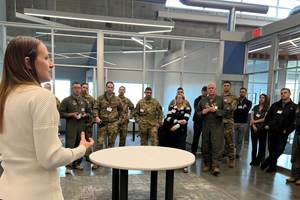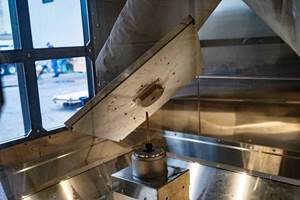America Makes Names 2024 Ambassador Award Winners
The Ambassador Award Program recognizes individuals who have continually demonstrated outstanding dedication to advancing America Makes and its mission to innovate and accelerate additive manufacturing to increase the nation’s global manufacturing competitiveness.
Mark D. Benedict, Ph.D., senior scientist, Convergent Manufacturing, Air Force Research Laboratory, was presented with America Makes’ 2024 Distinguished Collaborator Award. Source: America Makes
America Makes, the national additive manufacturing (AM) innovation institute, announced the recipients of its 2024 Ambassador Awards and Distinguished Collaborator Award at its annual Members Meeting and Exchange (MMX) event held August 6-7 in Youngstown, Ohio.
The Ambassador Award Program, launched in 2017, recognizes individuals who have continually demonstrated outstanding dedication to advancing America Makes and its mission. The 2024 class represents a cross section of the industry whose work has helped further advance additive technology and demonstrated the resilience of the AM community.
These champions also represent the progress made in AM technology, ecosystem expansion and workforce development.
America Makes’ 2024 Ambassadors:
- Rachael Andrulonis, director of Advanced Materials Research, National Institute for Aviation Research (NIAR)
- Cheryl Bowman, chief, High Temperature& Smart Alloys Branch, NASA Glenn Research Center
- Robert Carter, deputy chief, Materials & Structures Division, NASA Glenn Research Center
- Sarah Jordan, CEO, Skuld LLC
- Mark LaViolette, managing director, Deloitte Consulting
- Thierry Marchione, laser engineering specialist, Caterpillar (CAT)
- Kay Matin, president, AlphaSTAR Corp.
- Travis Mayberry, additive manufacturing lead, RTX Corp.
- Frank Medina, associate professor/director of Technology & Engagement, University of Texas at El Paso
- Marlee Rust, business development manager, General Electric Global Research
Also, during the event, Mark D. Benedict, Ph.D., a senior scientist in Convergent Manufacturing with the U.S. Air Force Research Laboratory, was presented with the 2024 Distinguished Collaborator Award. Established in 2014, recipients of this award are celebrated for cultivating effective collaborative relationships with academia, government and industry. Serving as the chief technology advisor at America Makes for nearly six years, the organization says that Benedict has played a pivotal role in the Institute’s strategic planning and defining project requirements as well as the selection and execution of its technical portfolio. He was recognized for his leadership and unwavering dedication to advancing the technologies, practices and innovation in the AM industry and his contributions to the Institute.
“The Institute has been pivotal in forming a Joint Services community focused on additive manufacturing and connecting that community with the companies and universities looking for problems to solve,” Benedict says. “There has always been such positive energy in this ecosystem. I am fortunate to have played a small part in connecting Department of Defense stakeholders with enthusiastic technical teams working to mature this technology. It is an honor to be recognized by the Institute for helping to make progress in this important technology.”
America Makes is the National Additive Manufacturing Innovation Institute. As the national accelerator for AM, America Makes is the nation’s leading and collaborative partner in AM and 3DP technology research, discovery, creation and innovation. Structured as a public-private partnership with member organizations from industry, academia, government and nongovernment agencies as well as workforce and economic development resources, the group is working together to innovate and accelerate AM to increase the nation’s global manufacturing competitiveness. Based in Youngstown, Ohio, America Makes is the first Institute within the Manufacturing USA infrastructure and is driven by the National Center for Defense Manufacturing and Machining (NCDMM).
Related Content
How a DOD-Funded Resilient Manufacturing Ecosystem (RME) Is Coming Together at Neighborhood 91
Pittsburgh’s additive manufacturing campus doubles as a test bed for a Department of Defense project aimed at developing a reproducible ecosystem for on-demand production of critical parts.
Read MoreThe Cold Spray Solution to the Casting, Forging Supply Chains
Startup HAMR Industries performs additive manufacturing work at Neighborhood 91 that provides an alternative to traditional casting and forging. Success so far has led to redefining the limits of its additive equipment.
Read MoreAdditive Manufacturing for Defense: Targeting Qualification
Targeting qualification in additive manufacturing for the defense industry means ensuring repeatability as well as reliability as there is much at stake, including human lives. Certain requirements therefore must be met by weapons systems used by the defense industry.
Read MoreThe Top 10 Additive Manufacturing Stories of 2024
Defense, space exploration, thermal management — these are some of the topics that captured the Additive Manufacturing audience’s interest in 2024. But there’s also an overarching theme: Don't wait for additive manufacturing to be perfect. Instead, leverage the applications perfect for AM.
Read MoreRead Next
3D Printed Polymer EOAT Increases Safety of Cobots
Contract manufacturer Anubis 3D applies polymer 3D printing processes to manufacture cobot tooling that is lightweight, smooth and safer for human interaction.
Read MoreProfilometry-Based Indentation Plastometry (PIP) as an Alternative to Standard Tensile Testing
UK-based Plastometrex offers a benchtop testing device utilizing PIP to quickly and easily analyze the yield strength, tensile strength and uniform elongation of samples and even printed parts. The solution is particularly useful for additive manufacturing.
Read MorePostprocessing Steps and Costs for Metal 3D Printing
When your metal part is done 3D printing, you just pull it out of the machine and start using it, right? Not exactly.
Read More





















